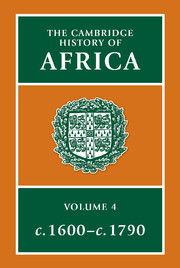Book contents
- Frontmatter
- Introduction
- 1 Egypt, the Funj and Darfur
- 2 The central Sahara and Sudan
- 3 North-West Africa: from the Maghrib to the fringes of the forest
- 4 The Guinea coast
- 5 Central Africa from Cameroun to the Zambezi
- 6 Southern Africa and Madagascar
- 7 Eastern Africa
- 8 Ethiopia and the Horn of Africa
- 9 Africa in Europe and the Americas
- Bibliographical Essays
- Bibliography
- Index
- References
2 - The central Sahara and Sudan
Published online by Cambridge University Press: 28 March 2008
- Frontmatter
- Introduction
- 1 Egypt, the Funj and Darfur
- 2 The central Sahara and Sudan
- 3 North-West Africa: from the Maghrib to the fringes of the forest
- 4 The Guinea coast
- 5 Central Africa from Cameroun to the Zambezi
- 6 Southern Africa and Madagascar
- 7 Eastern Africa
- 8 Ethiopia and the Horn of Africa
- 9 Africa in Europe and the Americas
- Bibliographical Essays
- Bibliography
- Index
- References
Summary
THE PROCESS OF CONSOLIDATION
The primary problem of the central Sudan during the seventeenth and eighteenth centuries was that of consolidation, of state and of society. The main stages of penetration and expansion occurred in earlier centuries: the arrival of outstanding individuals or groups; the more general encroachment of nomads upon settled realms; the transmission of Islam across the Sahara and its planting in the Sudan; the extension of a corresponding framework of trade; the crucial exodus of the court of the Saifawa from Kanem to Bornu towards the end of the fourteenth century. The same patterns may, indeed, be traced in the seventeenth and eighteenth centuries. In Wadai, with the coming of 'Abd al-Karīm in the early seventeenth century, there is an unusually late instance of the héros civilisateur theme. Nomad incursions continued, and, as records become fuller in later years, it is possible to analyse the contribution, probably overrated, of such people to state formation; and also, perhaps, by analogy to suggest the process which may have taken place in earlier times. The expansion of Islam was also repeated again and again, on the smaller stages of outlying states, such as Mandara, Bagirmi and Wadai. Even the exodus to Bornu was a continuing affair, often closely associated with nomad groups.
The persistence of these patterns of mobility is one major qualification to be attached to the fundamental theme of consolidation. Another arises from the fact that the same event may be seen either as illustrative of mobility, even of the dissolution of society, or of consolidation, depending upon one's point of view.
- Type
- Chapter
- Information
- The Cambridge History of Africa , pp. 58 - 141Publisher: Cambridge University PressPrint publication year: 1975
References
- 3
- Cited by



